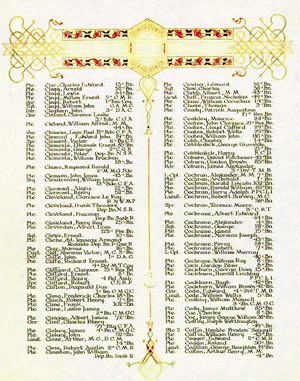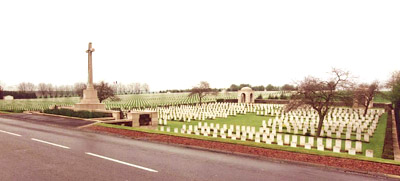

In memory of
Bombardier
JAMES "ALEXANDER" MacLean Coburn
August 22, 1886 - March 30, 1918
Military Service:
Service Number: 335954Age: 31
Force: Army
Unit: Canadian Field ArtilleryDivision: 3rd Div. Trench Mortar Bty.
Commemorated on Page 386 of the First World War Book of Remembrance.
Medium sized pop-up image
547 X 695, 96 dpi, 166 k
Military Attestation papers:
When a recruit signed up for the Canadian Expeditionary Force in WW I he filled in an attestation paper that indicated his willingness to serve in the military and provided such information as date of birth, next of kin, height, weight, complexion, occupation, etc. As such these papers are of genealogical importance. The links below are to a scanned copy of the attestion papers of James Alexander MacLean Coburn completed on 3 July 1916, in Woodstock New Brunswick.
Medium sized pop up image
of military attestation paper (front)
700 X 1121, 72 dpi, 50 kFull sized pop up image
of military attestation paper (front)
1015 X 1625, 72 dpi, 95 kMedium sized pop up image
of military attestation paper (back)
700 X 1121, 72 dpi, 32 kFull sized pop up image
of military attestation paper (back)
1015 X 1625, 72 dpi, 61 kDate of Enlistment:
July 3, 1916, Woodstock, New Brunswick, CanadaAdditional Information:
James "Alexander" MacLean Coburn, born 22 Aug 1886, son of John G. Coburn and Margaret Ann Nesbitt, Harvey, NB, died 30 Mar 1918, France, Battle of the Somme.
Cemetery:
La Targette British Cemetery, Pas de Calais,France.La Targette British Cemetery is in the Western angle of the cross roads at Aux-Rietz. This Cemetery was formerly known as the Aux-Rietz Military Cemetery, and was begun at the end of April, 1917, and used by Field Ambulances and fighting units until September, 1918. Sixteen graves were brought in from the immediate neighbourhood after the Armistice.
In March-April 1917, the artillery of the 2nd Canadian and 5th Divisions, and certain heavy artillery units, had their headquarters in a deep cave at Aux-Rietz. Nearly a third of the graves, including Bdr. Alexander Coburn, have an artillery connection.
The 21st Canadian Infantry Battalion erected a wooden memorial in the cemetery to their dead of April, 1917. The cemetery covers an area of 2,852 square metres and is enclosed by a stone curb on two sides, and on the other two by a low rubble wall.
The cemetery was designed by Sir Reginald Blomfield.
The cemetery contains 638 First World War burials, 41 of them unidentified. There are also three Second World War burials, two of which are unidentified.
Location:
Neuville-St Vaast is a village 6.5 kilometres north of Arras, a little east of the road from Bethune to Arras. La Targette British Cemetery lies to the south-west of the village on the north-west side of the road to the village of Maroeuil.Grave Reference:
I. J. 5.
La Targette British Cemetery, Pas de Calais,France
Medium sized pop-up image
800 X 362, 72 dpi, 100 k
The First Battle of Somme (1918) 21 Mar - 5 Apr 1918
The First Somme battle of 1918 is also known as the Battle of Saint-Quentin or the Second Battle of the Somme. It lasted from March 21–April 5 1918. The 1918 Spring Offensive or Kaiserschlacht was a series of German attacks along the Western Front during the First World War, which marked the deepest advances by either side since 1914. The German Artillery rained down shells on the British and Allied positions, purposely targeting the British artillery and rear lines of troops, ready for what they hoped would be a lighting attack to split the British and French Lines, hoping to push the British forces back to the channel. Casualties on both sides were horrendous.
The first attack of the German Spring Offensive (codenamed Michael) was launched from the Hindenburg Line, on March 21, in the vicinity of Saint-Quentin. It reached a crisis at Villers-Bretonneux a little to the east of the key Allied communications centre of Amiens. The winning of that battle by the Allies, marked the beginning of the end of the First World War, as this Western front was much the most significant by this stage and the German advance stalled largely through an inability to maintain supplies.
As an important part of the German tactics in this battle was to target artillery it is possible that Bdr. Coburn was killed in action on March 30 as part of routine German counter battery fire, although his death could have been accidental (e.g. faulty ammunition or artillery piece misfire).
Source:
Wikipedia, Veterans Affairs Canada


